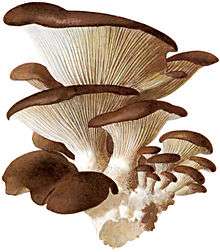Pleurotaceae
The Pleurotaceae are a family of small to medium-sized mushrooms which have white spores. The family contains four genera (Nematoctonus has been synonymized with Hohenbuehelia, but not all of its species have been moved to valid genera) and 94 species.[1] Members of Pleurotaceae can be mistaken for members of Marasmiaceae. Perhaps the best known member is the oyster mushroom, Pleurotus ostreatus.
| Pleurotaceae | |
|---|---|
 | |
| Pleurotus ostreatus Albin Schmalfuß, 1897 | |
| Scientific classification | |
| Kingdom: | Fungi |
| Division: | Basidiomycota |
| Class: | Agaricomycetes |
| Order: | Agaricales |
| Family: | Pleurotaceae Kühner (1980) |
| Type genus | |
| Pleurotus | |
| Genera | |
|
Agaricochaete | |
Many species in the genera Pleurotus and Hohenbuehelia are nematophagous, that is, they derive nutrition by consuming nematodes. This is made possible by hyphae that may have adhesive knobs that attach to passing nematodes and secrete nematotoxic compounds.[2][3]
See also
References
- Kirk PM, Cannon PF, Minter DW, Stalpers JA (2008). Dictionary of the Fungi (10th ed.). Wallingford: CABI. p. 549. ISBN 978-0-85199-826-8.
- Thorn RG, Moncalvo JM, Reddy CA, Vilgalys R (2000). "Phylogenetic analyses and the distribution of nematophagy support a monophyletic Pleurotaceae within the polyphyletic pleurotoid-lentinoid fungi". Mycologia. 92 (2): 241–52. doi:10.1080/00275514.2000.12061151. JSTOR 3761557.
- Koziak AT, Cheng KC, Thorn RG (2007). "Phylogenetic analyses of Nematoctonus and Hohenbuehelia (Pleurotaceae)". Canadian Journal of Botany. 85 (8): 762–73. doi:10.1139/b07-083.
External links
- " Pleurotaceae Kühner". Atlas of Living Australia.
This article is issued from Wikipedia. The text is licensed under Creative Commons - Attribution - Sharealike. Additional terms may apply for the media files.